| Home > Policy > White Paper, Notice, Announcement > White Paper > JAPANESE GOVERNMENT POLICES IN EDUCATION, SCIENCE, SPORTS AND CULTURE 1997 > Scientific Research Chapter 2 Section 1 1 | ||
According to the Survey of Research and Development conducted by the Management and Coordination Agency, there were approximately 673,000 researchers in Japan as of April 1 , 1996. A breakdown by affiliation shows that approximately 384,000, or over one-half, were employed by-companies. Those working in universities made up the next biggest group at about 243,000, while approximately 46,000 worked in research institutes. About 588,000 (almost 90%) were involved in research in the natural sciences. This percentage rose to 99% among company researchers. Over 90% of researchers in humanities and social science fields were employed in universities. ( Figure 2-1 ).
An analysis of annual trends in the number of researchers shows that the 1996 total Is approximately double the 1975 figure and 1.5 times higher than the 1985 level. The number of researchers has increased in all types of organizations, but the percentage of increase for companies has been greater than for research institutes and universities ( Table 2-1 ).
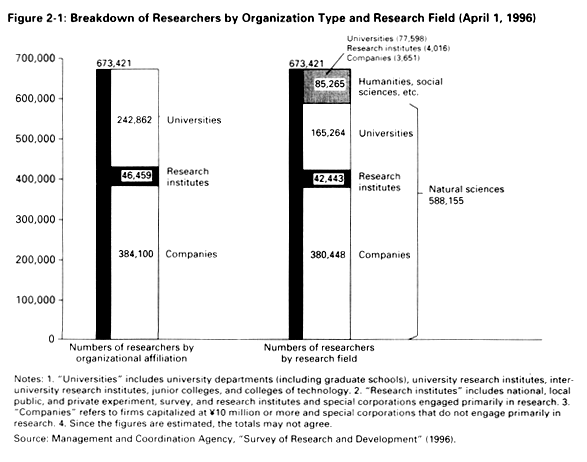
Teaching personnel in universities and inter-university research institutes play a central role in promoting scientific research (see Column). As of April 1, 1996, there were about 160,000 teaching personnel in these institutions ( Table 2-2 ).
By educating graduate students, universities and inter-university research institutes also play a leading role in training young researchers.
Analysis of the age mix of teaching personnel, however, shows a downtrend in the number of researchers in their twenties. This is one problem faced in maintaining the vitality of university research ( Figure 2-2 ). Training for young researchers must be improved to prevent a decline in opportunities for them to conduct research in positions of responsibility or a drop in the number of people who will be able to undertake research in the future.


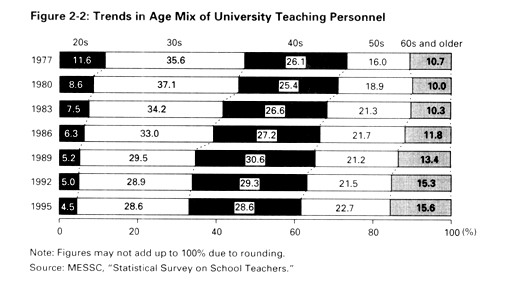
Scientific research is basically driven by individual researchers' unfettered ideas and commitment to research, so it cannot produce fruitful results without high-quality researchers. The level of scientific research in the future depends on how researchers are recruited and trained.
Most of the young researchers who are expected to take the lead in future research are also playing a vital role in current research activities and have the potential, by virtue of their flexibility, to open up new directions in research. Securing and training outstanding young researchers is, therefore, the most important task that must be accomplished if we are to improve and advance scientific research. Doing so necessitates policies that foster the following qualities.
(i)Creativity
: Most outstanding researchers have individuality, creativity, acute analytical skills, and lively curiosity. They also have broad perspectives and flexible intellects backed by extensive basic knowledge. Japan needs to foster young researchers who have these abilities and are constantly motivated to take on new research fields.
(ii) An international orientation
: In view of the growing importance of international scientific cooperation and exchange and the international community's rising expectations of Japanese scientific research, it will be important for researchers to understand global research trends and participate actively in exchanges with their counterparts in other countries.
(iii) Ability to respond aggressively to new fields
: Research is rapidly becoming more sophisticated and specialized. At the same time, developing interdisciplinary or totally new fields that go beyond traditional fields is becoming increasingly important to scientific progress. Japan needs to foster young researchers who can respond aggressively to these scientific trends.
(iv) Abundant human qualities
: Japan needs researchers who are aware of their role and mission in society and are able to keep society and scholarship as a whole within their field of vision, rather than confining themselves to increasingly narrow fields of specialization, and who, at the same time, can harmonize science and technology with humanity, the society, and the global environment. Researchers should therefore have an abundance of the human qualities that will enable them to understand correctly their roles and responsibilities in society.
In cooperation with other government organizations, MESSC is promoting a program to support l0,000 postdoctorals by FY2000. The aim of this program, which has been in progress since FY 1 996, is to recruit and train outstanding and creative young researchers.
The Science and Technology Basic Plan adopted in July 1996 calls for realizing the program's target by FY2000. In Fvl997 MESSC, the Science and Technology Agency, the Ministry of International Trade and Industry (MITI), and the Ministry of Agriculture, Forestry and Fisheries will provide support to 7,926 postdoctoral researchers, an increase of 1,809 over the previous year. Of these, MESSC is supporting 5,701 researchers, an increase of 1,145 over the previous year. This represents over 70% of the total, evidence of the importance of MESSC's role in the program.
MESSC is promoting the following as part of the Program to Support 10,000 Postdoctoral Researchers. ( Table 2-3 , Figure 2-3 ).
(a) JSPS Research Fellowships for Young Scientists
: To provide young researchers at the start of their careers with the opportunity to engage in full-time research and with the autonomy to freely select themes and venues for their research, this program appoints outstanding young researchers who are currently enrolled in, or have completed, doctoral programs and who wish to carry out full-time research in universities or other research institutions. Those who are selected have opportunities to receive fellowships and research grants for periods of two or three years. This program was established in 1985 by the Japan Society for the Promotion of Science. It has been enhanced over the years and now forms the core of the Program to Support l0,000 Postdoctorals. This highly regarded program is an established part of the system for recruiting and training the young researchers who contribute to scientific research in Japan. ( Figure 2-4 )
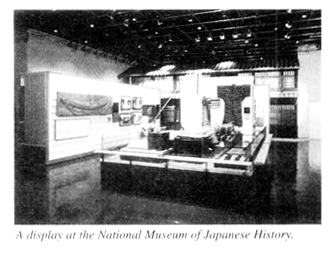
In FY 1997, a total of 3,570 doctoral course students (DCs) and postdoctoral researchers (PDs) will be supported under these fellowships (an increase of 400 over the previous year).
(b) JSPS Research Fellowships for Young Scientists (Cancer, New Program, COEs)
: Support is provided for young researchers who have completed doctoral courses and are participating in cancer research and research under the New Program System and the Center of Excellence (COE) Formation Program. A total of 80 will receive these fellowships in fiscal 1997, an increase of 10 over the previous year.
(c) JSPS Postdoctoral Fellowships for Research Abroad
: This program was created to enable young Japanese researchers to devote themselves to long-term research in overseas universities and research institutes by providing living allowances, research funds, and other forms of assistance. The aim is to foster outstanding researchers who have an international perspective. In fiscal 1997, the number of researchers supported under this program will increase by 2-5 to 125.
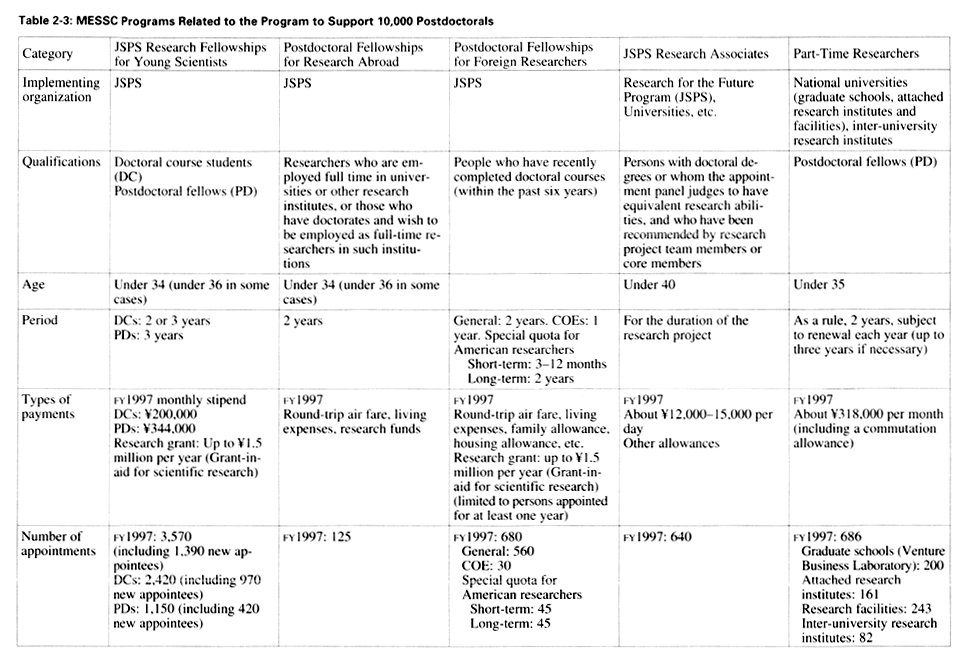
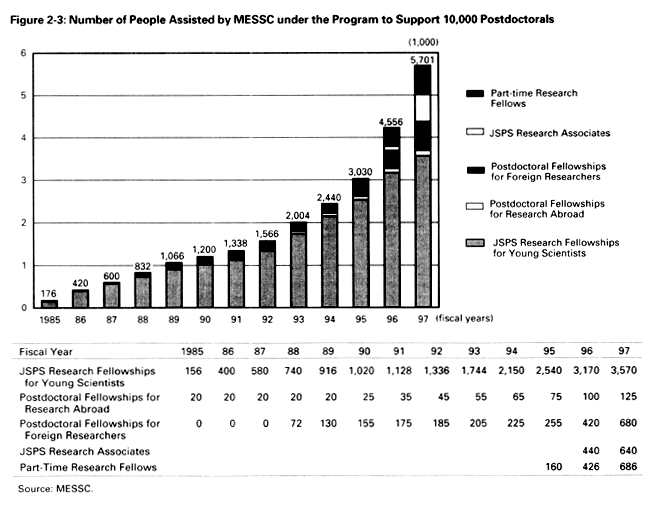
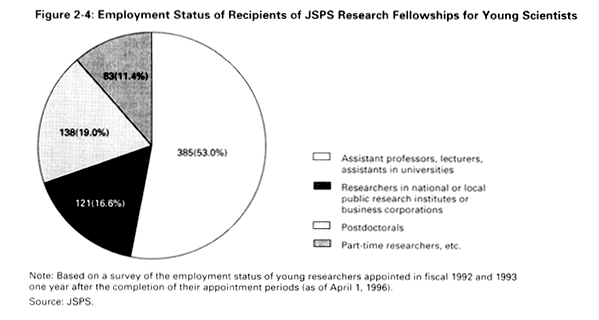
(d) JSPS Postdoctoral Fellowships for Foreign Researchers
: The purpose of this program is to contribute to training young researchers who have just obtained their doctorates in other countries by accepting them into Japanese universities. They receive living allowances and other assistance. The program also contributes to the training of young Japanese researchers by providing opportunities for interaction with researchers from other countries. In FY1997 support will be provided to 680 people, a rise of 260 over 1996.
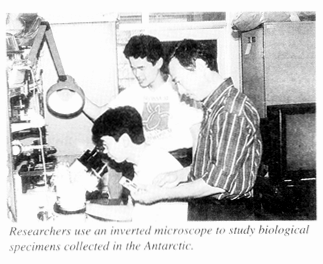
(e) JSPS Research Associates under the Research for the Future Program
: The JSPS Research for the Future Program was launched in FY1996. Young researchers who have completed doctoral courses can be employed by research institutes to participate In a research project under this program. In FY 1 997 the number of participants is expected to total 640, an increase of 200 over the previous year.
(f) Part-Time Researchers
: By employing young postdoctoral researchers to work as part-time researchers, this program aims to contribute to recruiting, training, and improving the quality of young researchers and to facilitate research projects in national universities and inter-university research institutes. In fiscal 1997 assistance will be provided to 486 people, 160 more than the 1996 figure.
The Venture Business Laboratory (VBL) program was established to encourage creative research and development in the graduate schools of national universities as a way of sowing the seeds for new venture businesses. In fiscal 1997 the number of people receiving support under this scheme will grow by 100 to 200.
Research support personnel can be broadly divided into three categories depending on how they are involved in the activities of research organizations and projects. Research support workers assist researchers and support research work directly: technical support workers mainly perform essential technical tasks; and administrative support workers primarily handle research-related administrative and accounting tasks. These employees are indispensible human resources, the fundamental components of universities and other research organizations.
A MESSC survey of the research environment (page 42) shows that on the average, a full-time research support worker supports about eleven researchers, a technical support worker, nine, and an administrative support worker, eight. For part-time employees, the figures are approximately 14, 25, and 13, respectively ( Figure 2-5 ). Around 70% of survey respondents thought the number of such support workers was inadequate.
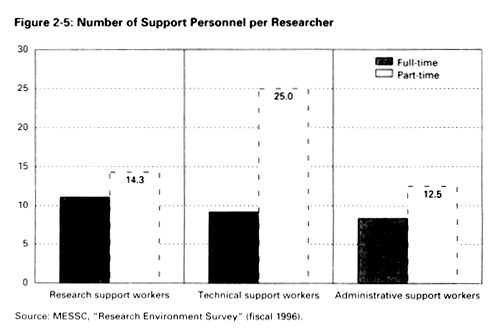
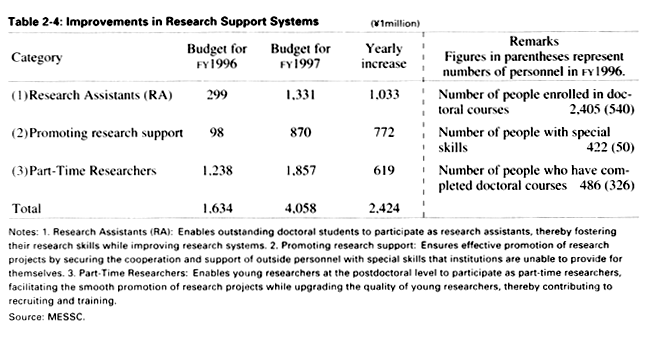
One of the goals laid down in the Science and Technology Basic Plan is to increase the number of support staff in national universities and affiliated research institutions to about one for every two researchers as soon as possible. The eventual aim is to achieve a ratio of one support worker per researcher, as is the case in the United Kingdom, Germany, and France. MESSC therefore substantially expanded its funding for Research Assistants (RA), promoting research support, and Part-Time Researchers in fiscal 1 997, an essential measure for effective promotion of research projects at national universities and inter-university research institutes ( Table 2-4 ).
| Back to Top | MEXT HOME |